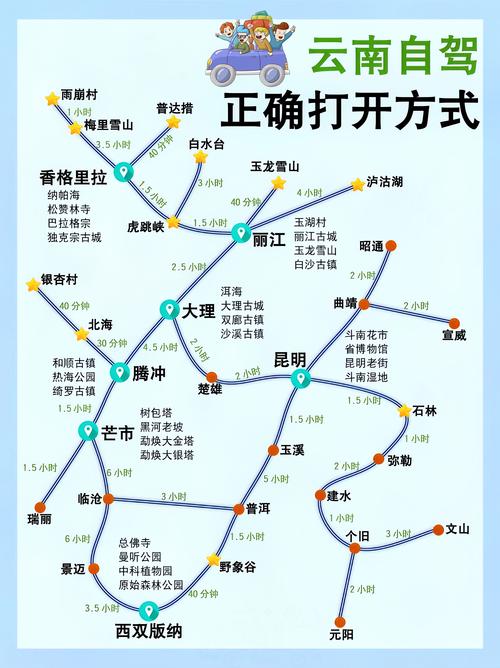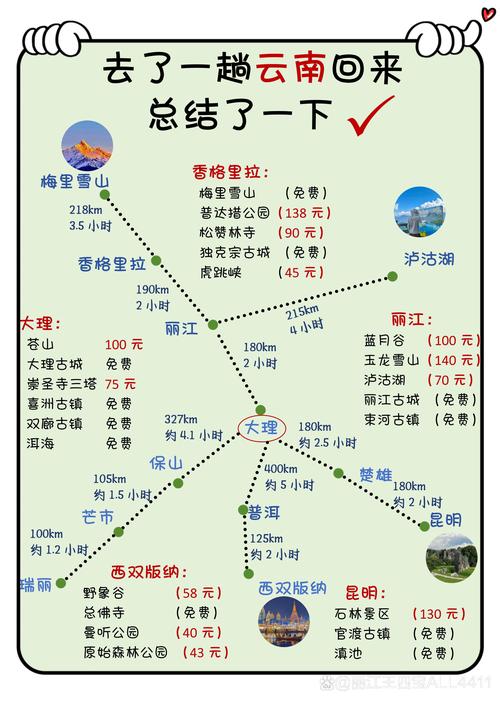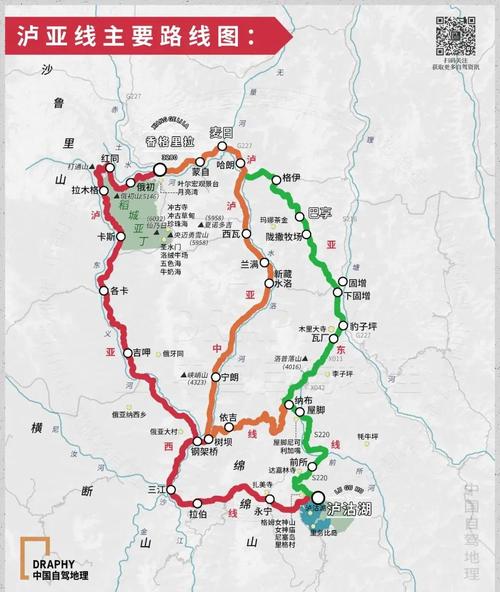核心思路
从南充出发,进入云南主要有两条通道:

- 大通道(G85银昆高速):直接经昭通进入云南,路程最短,适合时间紧张、目标明确的游客。
- 风景通道(G5/G56):经攀枝花/大理进入云南,路程稍长,但沿途风光壮丽,适合喜欢自然风光的游客。
下面我将基于这两条通道,为您规划几条经典的自驾线路。
经典全景线(7-10天)——不走回头路,一次玩转滇东南/滇西北
这是最受欢迎的方案,可以一次性领略云南最精华的风光,您可以根据兴趣选择滇东南或滇西北。
A. 滇东南喀斯特与风花雪月线(适合喜欢人文、梯田、古镇、湖泊的游客)
这条线路将云南东部的喀斯特奇观与西部的苍山洱海完美结合。
- 路线概览:南充 → 昭通(可选)→ 石林 → 普者黑 → 元阳梯田 → 建水古城 → 昆明 → 大理 → 丽江
- 总里程:约 1800-2000 公里
- 最佳时间:全年皆宜,秋季(9-11月)看梯田灌水,冬季(12-2月)看梯田放水,春季看油菜花。
- 行程亮点:世界自然遗产、元阳梯田的日出日落、普者黑的田园风光、建水古城的古韵、大理的浪漫、丽江的柔软。
详细行程建议(8天7晚):

-
D1: 南充 → 昭通 (约400km, 5小时)
上午出发,沿G85银昆高速直达昭通,下午可在昭通古城逛逛,品尝当地特色“昭通小草坝天麻炖鸡”,然后入住休息,为明天的高强度驾驶养精蓄锐。
-
D2: 昭通 → 石林 → 普者黑 (约450km, 6小时)
- 上午从昭通出发,前往石林(约3.5小时),游览“天下第一奇观”石林,感受大自然的鬼斧神工。
- 下午驱车前往普者黑(约2.5小时),傍晚时分,在普者黑湖边散步,欣赏“水上田园”的宁静。
-
D3: 普者黑全天深度游
 (图片来源网络,侵删)
(图片来源网络,侵删)- 上午可以乘坐小船,穿梭于溶洞和荷叶之间,感受“舟行碧波上,人在画中游”的意境。
- 下午可以去青龙山登高望远,俯瞰整个普者黑的全景,或去天鹅湖看候鸟(季节性)。
- 住宿建议:住普者黑景区内的特色民宿,方便看日出和日落。
-
D4: 普者黑 → 元阳梯田 (约280km, 4.5小时)
- 早起,前往多依树景区看壮丽的日出,之后前往坝达景区,拍摄“老虎嘴”的日落和壮观的梯田层次。
- 住宿建议:强烈建议住在箐口村或坝达村的客栈,方便次日清晨前往观景台,无需长途奔波。
-
D5: 元阳梯田 → 建水古城 (约150km, 2.5小时)
- 早上可以去爱春村、阿者科等小众村落,感受哈尼族村落的淳朴。
- 下午驱车前往建水古城,游览朝阳楼、朱家花园、文庙,感受“文献名邦”的古韵。
- 美食推荐:建水烧豆腐、汽锅鸡、草芽米线。
-
D6: 建水 → 昆明 → 大理 (约550km, 6-7小时)
- 上午在建水古城悠闲逛逛,品尝美食。
- 下午驱车前往昆明(约2.5小时),可以短暂停留在滇池边。
- 之后从昆明转上杭瑞高速G56,前往大理(约3.5小时),抵达大理后,入住大理古城或洱海边的客栈。
-
D7: 大理深度游
- 环游洱海:租一辆车或电动车,沿着环海西路东路,途经喜洲古镇(看白族民居、尝喜洲粑粑)、双廊古镇、挖色小镇等。
- 晚上在大理古城逛逛人民路、洋人街,感受悠闲氛围。
-
D8: 大理 → 丽江 (约180km, 2.5小时)
- 上午睡个懒觉,之后驱车前往丽江。
- 下午在丽江古城(大研古城)闲逛,登万古楼,四方街感受纳西风情。
- 返程准备:丽江有机场和火车站,交通非常方便,可以在此结束行程,飞回南充或继续前往其他地方。
B. 滇雪山秘境线(适合喜欢雪山、峡谷、徒步的游客)
这条线路将目光投向了壮丽的雪山和神秘的峡谷。
- 路线概览:南充 → 攀枝花 → 丽江 → 虎跳峡 → 香格里拉 → 泸沽湖 → 返程
- 总里程:约 2000 公里
- 最佳时间:春季(3-5月)、秋季(9-11月),气候宜人,冬季可看雪山,但部分路段可能有雪。
- 行程亮点:玉龙雪山、虎跳峡的雄奇、香格里拉的信仰、泸沽湖的女儿国风情。
详细行程建议(8天7晚):
-
D1: 南充 → 攀枝花 (约450km, 5小时)
沿G42沪蓉高速转G5京昆高速,抵达“钢城”攀枝花,下午可以游览攀枝花中国三线建设博物馆或格萨拉生态区。
-
D2: 攀枝花 → 丽江 (约300km, 4.5小时)
沿G56杭瑞高速进入云南,沿途风光从干热河谷逐渐变为秀美山川,下午抵达丽江,入住并适应海拔。
-
D3: 丽江 → 玉龙雪山 → 丽江古城
- 包车或自驾前往玉龙雪山,游览甘海子、蓝月谷,乘坐冰川大索道登顶4680米。
- 晚上返回丽江古城,欣赏《印象丽江》演出。
-
D4: 丽江 → 虎跳峡 → 香格里拉 (约180km, 3.5小时)
- 上午前往虎跳峡,徒步上虎跳或中虎跳,感受“万里长江第一峡”的磅礴气势。
- 下午翻越白坝,进入香格里拉(海拔约3300米),游览独克宗古城,转动世界最大的转经筒。
-
D5: 香格里拉一日游
- 上午前往普达措国家公园,属都湖、碧塔海、弥里亚塘的高原湿地风光令人沉醉。
- 下午参观松赞林寺,感受“小布达拉宫”的庄严。
-
D6: 香格里拉 → 泸沽湖 (约200km, 5小时)
- 这一天路程较长,且多为山路,需谨慎驾驶,沿途风景绝美,翻越山脉即可看到泸沽湖。
- 下午抵达后,可乘猪槽船游湖,晚上参加篝火晚会。
-
D7: 泸沽湖全天游
- 环湖游:里格半岛、里务比岛、女神湾、情人滩等。
- 探访摩梭母系文化,走婚桥,了解“女儿国”的独特生活。
-
D8: 泸沽湖 → 返程 (约600km, 8-9小时)
上午从泸沽湖出发,经丽江、攀枝花,沿原路返回南充,这是一段非常辛苦的返程路,建议早出发。
小众休闲线(5-7天)——避开人潮,体验慢生活
如果您时间有限,或者不喜欢太赶行程,可以选择这条线路。
- 路线概览:南充 → 大理 → 沙溪古镇 → 诺邓古村 → 返程
- 总里程:约 1200 公里
- 特点:节奏慢,深度体验,游客相对较少。
详细行程建议(5天4晚):
-
D1: 南充 → 大理 (约900km, 10小时)
一路狂奔,直达大理,入住后好好休息。
-
D2: 大理 → 沙溪古镇 (约120km, 2小时)
- 上午睡到自然醒,下午驱车前往“茶马古道上唯一幸存的古集市”——沙溪古镇。
- 在四方街的古戏台下喝杯咖啡,感受原始而宁静的氛围。
-
D3: 沙溪古镇全天
在古镇里闲逛,登兴教寺,去周边的村落徒步,如欧阳大院、华地坪村。
-
D4: 沙溪 → 诺邓古村 → 昆明 (约550km, 7小时)
- 上午前往千年白族村寨——诺邓古村,品尝独一无二的诺邓火腿。
- 下午驱车前往昆明,入住。
-
D5: 昆明 → 南充 (约900km, 10小时)
上午可以在翠湖公园逛逛,然后开始返程。
自驾游重要注意事项
- 车辆检查:出发前务必对车辆进行全面检查,特别是刹车、轮胎、机油和冷却液,云南多山路,对车况要求高。
- 驾驶安全:
- 山路驾驶:弯道减速,鸣笛示意,靠右行驶,切勿超速和占用对向车道。
- 高原反应:丽江、香格里拉等地海拔较高,驾驶时注意反应,避免剧烈运动,车上可备上氧气瓶。
- 天气变化:云南天气多变,“一山有四季,十里不同天”,出行前务必查询沿途天气预报。
- 住宿预订:旅游旺季(节假日、寒暑假),务必提前预订住宿,尤其是在热门景区(如普者黑、泸沽湖)。
- 必备物品:
- 衣物:云南早晚温差大,务必带上冲锋衣、薄羽绒服等保暖衣物。
- 防晒:高原紫外线极强,防晒霜、太阳镜、帽子、唇膏是必需品。
- 药品:感冒药、肠胃药、创可贴、以及个人常用药。
- 证件:身份证、驾驶证、行驶证。
- 加油:进入山区后,加油站间隔较远,看到油站尽量加满油,不要等到油灯亮起。
希望这份详细的攻略能帮助您规划一次完美的南充到云南自驾游!祝您旅途愉快!




